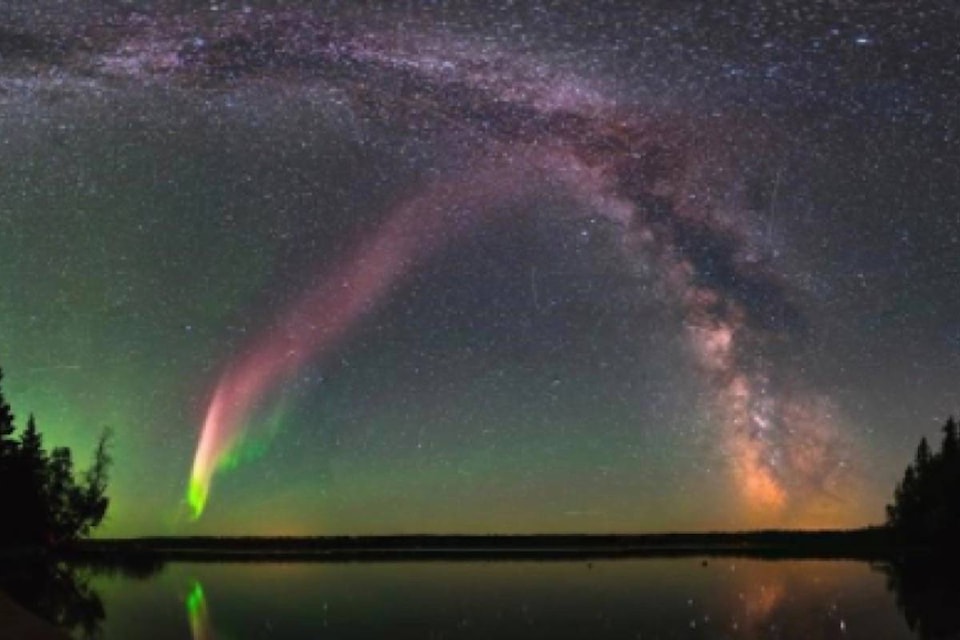Amateur scientists in Canada have helped researchers discover a new type of northern lights.
The glowing ribbon of purple ‚ÄĒ and sometimes green ‚ÄĒ that runs east-west in the night sky has been observed and photographed by aurora borealis chasers for years.
‚ÄúMy involvement is being the goofball who named it Steve,‚ÄĚ said Chris Ratzlaff, a Calgary photographer who‚Äôs a co-author of a research paper published Wednesday in the journal Science Advances.
‚ÄĒ Phenomenal Steve (@StevePhenomena)
The luminous light, distinct from traditional aurora, was previously undocumented in scientific literature and little was known about how it formed.
What has been learned by scientists at NASA and various universities is that the phenomenon is associated with a subauroral ion drift ‚ÄĒ a powerful current created by charged particles in the Earth‚Äôs upper atmosphere. The arc is an optical manifestation of that ion drift.
The research started four or five years ago with the Alberta Aurora Chasers, a Facebook group Ratzlaff helps manage that has grown to about 16,000 members.
‚ÄúWe have a lot of people who are out staring at the night sky. They are looking up for the northern lights,‚ÄĚ he said in an interview. ‚ÄúSometimes Steve appears ‚ÄĒ and Steve is a phenomenon that kind of likes to hang out over Alberta, over the prairies.‚ÄĚ
Photographers put together a large picture library of Steve and took it to scientists at the University of Calgary and, later, to NASA.
Eric Donovan, an associate professor in the department of physics and astronomy at the university, hosted a guest lecture in 2014 by NASA physicist Elizabeth MacDonald.
‚ÄúThe room was packed and, not only that, it was packed with people I didn‚Äôt know,‚ÄĚ said Donovan.
They were members of the aurora chasers group who were involved in MacDonald’s Aurorasaurus project, which captures descriptions of northern lights on social media to help researchers better understand them.
After the talk, the two scientists went to a nearby pub with some of the aurora chasers.
‚ÄúThey started showing me their beautiful, beautiful photos of aurora,‚ÄĚ said Donovan.
One of the photographers suggested he got a picture of the proton arc, a rare type of aurora.
‚ÄúThere is such a thing as proton aurora, but it‚Äôs always sub-visual so they wouldn‚Äôt even know to point a camera to take a picture of it,‚ÄĚ said Donovan. ‚ÄúBut I said, ‚ÄėWhy don‚Äôt you show me what you‚Äôve got?‚Äô
‚ÄúHe showed me this beautiful picture of this thing and I don‚Äôt know what this thing is ‚ÄĒ and that‚Äôs really amazing because I‚Äôve probably looked at more photos of the aurora that any other living person on the planet right now.‚ÄĚ
The photographers said they had been seeing it fairly regularly.
Donovan told him they couldn’t call it a proton arc, because it didn’t fit the physical properties. He suggested it needed a non-scientific name.
‚ÄúI proposed we call it Steve and it stuck,‚ÄĚ said Ratzlaff.
It‚Äôs a reference to the animated movie ‚ÄúOver the Hedge‚ÄĚ about animals that encounter a giant hedge in their neighbourhood and get scared because they don‚Äôt know what it is.
‚ÄúThe squirrel comes up and says, ‚ÄėLet‚Äôs call it Steve‚Äô ‚Ķ and they are all OK with it.‚ÄĚ
Ratzlaff said Steve was just meant to be a temporary name, but scientists have decided to keep it ‚ÄĒ only it now stands for Strong Thermal Emission Velocity Enhancement.
Scientists will now try to get a spectrum ‚ÄĒ or band of colours ‚ÄĒ for Steve by going back to the aurora chasers with a spectrograph they‚Äôve attached to a digital camera.
‚ÄúThey are going to drive around and they are going to see Steve sometime in the next few months and they are going to get us a spectrum,‚ÄĚ he said. ‚ÄúWhen we get the spectrum, we‚Äôll see the real science starting.‚ÄĚ
By Colette Derworiz in Edmonton
The Canadian Press



